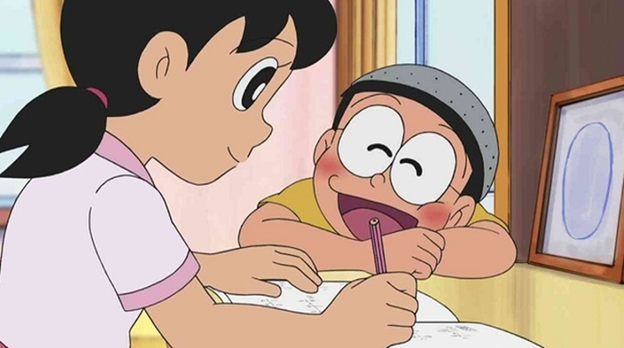Doraemon là bộ truyện tranh nổi tiếng của Nhật Bản được sáng tác bởi tác giả Fujiko Fujio. Các nhân vật trong manga này trở thành một phần tuổi thơ của nhiều thế hệ. Đã bao giờ bạn tự hỏi, liệu bạn học được điều gì từ nhân vật trong truyện? Đặc biệt là với các cô nàng công sở, bạn học được gì từ Shizuka được nhiều người yêu quý?
Shizuka là ai?
Shizuka là cô bé 9 tuổi trong bộ truyện tranh nổi tiếng Doraemon. Shizuka là bạn học chung lớp, là vợ tương lai của Nobita. Cô luôn đứng ra bênh vực khi Nobita bị bắt nạtCô là một cô gái đáng yêu, xinh xắn và hiền lành. Shizuka luôn được mọi người xung quanh yêu quý và quan tâm. Đặc biệt, ở Shizuka có một vài đức tính tốt mà các cô nàng công sở cần phải học tập.
Bài học từ nhân vật Shizuka cho cô nàng công sở

1. Luôn phải chỉn chu, chú ý đến ngoại hình
Shizuka là một cô bé vô cùng dễ thương. Cô xuất hiện với đôi mắt to tròn, gương mặt bầu bĩnh. Hai bím tóc luôn được thắt hình hoa anh đào gọn gàng. Mỗi lần xuất hiện, cô đều ăn mặc rất gọn gàng. Thường là những chiếc váy màu trắng, hồng. Cô chỉn chu từ quần áo, giày dép đến đầu tóc.
Đối với một cô nàng công sở, không cần quá điệu đà nhưng bạn cũng nên để ý tới vẻ ngoài. Đừng xuất hiện với mái tóc rối tung hay quần áo xộc xệch, nhăn nhúm. Một ngoại hình chỉn chu sẽ giúp bạn tự tin hơn. Một nghiên cứu của Tạp chí Tâm lý học cho hay: Những người mặc bộ đồ quần áo phù hợp sẽ thực hiện tốt công việc của mình hơn.
2. Luôn chăm chỉ, chịu khó, tập trung trong học tập, công việc Dù chỉ là một cô bé 9 tuổi nhưng Shizuka luôn chịu khó và chăm chỉ. Cô từ chối những chuyến đi chơi đầy hấp dẫn với Nobita vì thường xuyên phải đến lớp học piano. Mặc dù Shizuka thích violin hơn piano. Đang ở tuổi ăn, chơi, chưa cần lo nghĩ gì nhưng Shizuka đã biết điều gì cần thiết cho mình. Cô luôn chăm chỉ làm bài tập về nhà và đạt được nhiều điểm 90, 100. Đức tính cần cù, chịu khó này cũng là điều các cô nàng công sở cần học tập. Vì thành công được tạo từ thiên tài chỉ là 1%, 99 còn lại là bằng mồ hôi và nước mắt. Cần cù và chăm chỉ chưa bao giờ là thừa. Nó giúp bạn bồi dưỡng kiến thức, hoàn thiện bản thân. Chỉ cần cố gắng, nỗ lực làm việc, bạn sẽ được đền đáp xứng đáng. Vì “kiến tha lâu cũng đầy tổ”.
3. Luôn sẵn sàng giúp đỡ, quan tâm mọi người Shizuka là người có tấm lòng nhân hậu, luôn quan tâm, giúp đỡ mọi người. Cô chăm sóc cho những người yếu, động vật bị bỏ rơi. Cô luôn quan tâm và giúp đỡ Nobita khi cậu bị Jaian và Suneo bắt nạt. Shizuka hay mời Nobita đến để học cùng mặc dù Nobita học rất dở. Cô còn hay để Nobita thử bánh mình mới làm. Ước mơ của Shizuka là trở thành một y tá hay nữ tiếp viên hàng không. Ước mơ này phản ánh sự tốt bụng của cô.
Chuyên gia tâm lý Robert B. Cialdini từng nói rằng, môi trường công sở không thể tránh khỏi sự ganh đua, tị nạnh của đồng nghiệp khác. Tuy nhiên, đừng vì thế mà bạn lại ích kỷ, từ chối giúp đỡ mọi người. Các cô nàng công sở hãy sẵn sàng giúp đỡ các đồng nghiệp khi có thể. Việc đó giúp bạn tạo các mối quan hệ và danh tiếng tốt. Xây dựng hình ảnh một nhân viên tốt tính và luôn sẵn sàng giúp đỡ mọi người sẽ giúp phát triển công việc của bạn. Giúp đỡ người khác giúp bạn vui vẻ và sống tích cực hơn.
4. Biết kiên quyết và mạnh mẽ đúng lúc Tuy được xây dựng với hình ảnh nữ tính, dịu dàng và hiền lành nhưng Shizuka luôn biết kiên quyết và mạnh mẽ đúng lúc. Khi Nobita mượn vở cô để chép bài, cô đã thẳng thừng từ chối. Vì chép bài không giúp Nobita tốt hơn mà chỉ làm cậu ý lại. Cô từ chối lời rủ đi chơi của Nobita khi cô chưa làm xong bài tập hay phải học đàn. Sự quyết liệt và mạnh mẽ để bảo vệ quan điểm cá nhân là đức tính tốt của Shizuka.
Với các cô nàng công sở, dịu dàng, điềm đạm là điều cần thiết. Tuy nhiên, bạn cũng cần sự thẳng thắn, mạnh mẽ để bảo vệ quan điểm đúng của mình. Chỉ bảo vệ quan điểm của mình chứ không phản bác, nói quan điểm của mọi người là sai trái. Kiên quyết và mạnh mẽ giúp bạn không trở thành kẻ “đẽo cày giữa đường”.
Truyện tranh Doraemon đã “vẽ giấc mơ của trẻ em” trên toàn thế giới. Chiếc vé thần kỳ trở về tuổi thơ không chỉ để giải trí, Doraemon còn chứa đựng những bài học, câu chuyện đầy tính nhân văn. Đặc biệt là với cách xây dựng hình ảnh Shizuka, các cô nàng công sở có thể rút ra bài học riêng cho mình.
Nguồn bài viết: https://jobsgo.vn/blog/meo-song-sot-noi-cong-so-hay-hoc-theo-shizuka-trong-doraemon/

 Log in with Facebook
Log in with Facebook 






